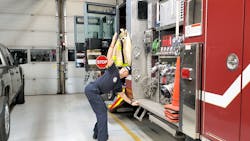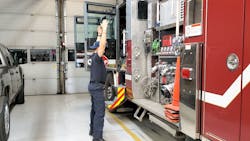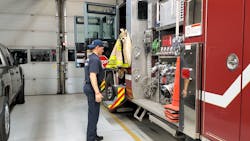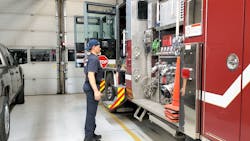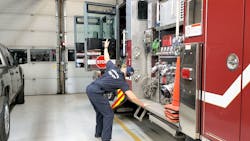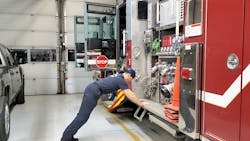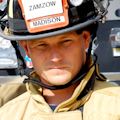Health & Wellness: Stretching—Your Body, Your Performance, Your Career
A tradition of the fire service is to check your gear and apparatus to make sure that it’s functioning properly. You also exercise all of the equipment that’s on the engine and truck to make sure that it, too, is functioning. This might include starting and warming up saws, engaging the pump and turning on various EMS equipment.
Do you do the same for your body and your muscles?
Think about it: Your muscles need to be lubricated and prepped just as the equipment on the rig does. What you might not know is that a proper warmup and stretch routine can help you to perform better throughout the day, to reduce possible injuries and to help you to feel better.
Pre-shift stretching and warmup exercise reduce the risk of musculoskeletal injuries by improving muscular balance and posture, improving muscle coordination and reducing fatigue.
Muscular balance and posture
Stretching enhances nerve conductivity, which is the time that it takes an impulse to travel to the brain and back to the muscle. It also helps opposing muscle groups work in a more coordinated fashion. Soft tissue structures can be realigned by stretching. This reduces the effort that’s required to maintain good posture in activities of daily living. Muscle coordination is improved, too.
Stretching also reduces fatigue by allowing for greater elasticity of tissues through the increase of tissue temperatures. The efficacy of joint synovial fluid (the lubricant for bones and articular cartilage) can be improved via stretching, because circulating and coating the joint surface reduces joint degeneration
Tightness and resistance in tendons and muscles can be diminished when you stretch, while a joint’s capability to move through a greater range of motion through less energy can be increased.
Static stretching
When a stretch is held in a challenging but comfortable position for a period of time (usually between 10–30 seconds), it’s referred to as a static stretch. This is the most common form of stretching in the realm of general fitness, and, when properly executed, it’s considered safe and effective for improving overall flexibility.
Static stretching used to be the gold standard for flexibility exercise. Back in high school, you probably were taught to perform static stretching before you performed a sport or exercise. However, science has moved on.
Researchers now believe that some static stretching for 20–30 seconds before the body is warmed up is a waste of time and can pose a potential risk. In a recent study that was conducted at the University of Nevada, Las Vegas, athletes generated less force from their leg muscles after static stretching. The study also found that statically stretching “cold” muscles can decrease muscle strength and power. That said, the research isn’t telling us that static stretching shouldn’t be used but that it needs to be performed when muscles are warmed and pliable for better results.
Dynamic stretching
The movements of dynamic stretching are very similar to static stretches, but they are performed by moving through a challenging but comfortable range of motion repeatedly. Although dynamic stretching requires more thoughtful coordination than static stretching, dynamic stretching is gaining favor among athletes, trainers and physical therapists. That ties to its apparent benefits of improving functional range of motion and mobility.
Dynamic stretching increases the range of motion of your joints as well as the flow of blood and oxygen to soft tissues. By stretching dynamically at the start of your shift, you will prepare your body for the possible physical exertions of the day.
Note: Dynamic stretching shouldn’t be confused with old-fashioned ballistic stretching. (Remember the bouncing toe touches from PE classes?) Dynamic stretching is controlled, smooth and deliberate, whereas ballistic stretching is uncontrolled, erratic and jerky.
How do you perform dynamic stretches? Rather than have you hold your stretches, as in static stretching, you move your body into position just for a few seconds and then go back to your starting position. This “wakes up” your muscles, including your body’s small muscles, which helps with balance and increases muscle efficiency.
Dynamic stretches prepare your body for the random, quick movements of the fireground by fine-tuning nerves and activating muscle feedback mechanisms. Here’s why that’s important: Let’s say that you step off of the rig and your foot slips off of the step. How well your body reacts to that slip depends on your muscle efficiency and balance.
A proper warmup at the beginning of your shift will switch on your body’s small muscles and help your body to react efficiently and without injury. Generally, you should do 5–10 repetitions of these dynamic movements. If you are new to dynamically warming up, these routines might not feel like a warmup but like a full-blown workout. Don’t worry. Your body quickly will condition itself to the exercises, and when you’re done, you’ll feel warmed up, rather than worn down.
The warmup routine
Based on research and experience working with athletes, including firefighters, I believe that the most effective way to warm up for your shift is to perform dynamic stretches and follow that with some static stretching and foam rolling. The combination is the most effective way to improve mobility for the day and for your career.
The exercises in this routine target the muscles of the hips, back, shoulders and knees, which are the areas that fire rescue athletes are prone to injure.
Here are some guidelines to consider when performing this routine to begin your shift:
- Start with dynamic movements by performing 5–10 reps of each exercise. You will want to move into position and hold the stretch for only a few seconds then return to the starting position. Move from one movement to the next for at least one circuit. If you are very tight or sore, you might want to consider performing the dynamic routine twice.
- After completing the dynamic warmup circuit, you can perform each movement statically and hold the stretches for 20–30 seconds. Make sure that you perform at least one dynamic circuit before performing static stretches.
- Always maintain good posture throughout any of the movements. Always try to keep your head and shoulders in proper alignment.
- Never “pain” through the movement and stretch. You want to find a point in the stretch that is slightly uncomfortable but never painful. If you start to experience pain in any movement, stop.
- Don’t hold your breath. Breathe nice and easy and try to relax your body and muscles as you move through each exercise.
Think of this routine as taking a few minutes to warm up a car that has been sitting outside in cold temperatures all night. You also can think of it as your body’s morning checklist—activating nerves and waking muscles with each movement. Consistently performing this routine before your shift will improve the long-term mobility and flexibility of your muscles. By doing these exercises, you will be able to improve your performance, reduce your chances of injury and prolong your career.
Y squats
Step ups
Reach and rotate
Start in a push-up position with your hands on a step or on the baseboard of the apparatus. Take one large step forward with your foot, aiming for the outside of your arm on the same side. Make sure that the head and shoulders stay straight and be sure to not force the movement; let your leg swing as far as it comfortably can, pause for a couple of seconds and return to the starting position. Repeat on the other side. Try to perform 5–6 reps on each side. You will feel this exercise in the hips, hamstrings and inner thighs. This is a great movement to perform statically after the circuit.
Think of this routine as taking a few minutes to warmup a car that has been sitting outside in cold temperatures all night. You also can think of it as your body’s morning checklist—activating nerves and waking muscles with each movement. Consistently performing this routine before your shift will improve the long-term mobility and flexibility of your muscles. By doing these exercises, you will be able to improve your performance, reduce your chances of injury and prolong your career.
About the Author
Aaron Zamzow
Aaron Zamzow is a firefighter/training officer for Madison, WI, Fire Department. He holds a bachelor’s degree in health/wellness and has 20 years of experience as a fitness trainer. He created Fire Rescue Fitness and authors programs that are aimed at getting fire rescue athletes fit for duty.
